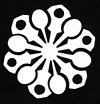 Here's a standard pattern you've never seen here before: plaid! Plaid (or properly, Tartan) has been worn in Scotland for thousands of years (possibly), though the first written records of it come from the mid-16th century. According to this history of Tartan, the different patterns were originally simply regional, and not claimed by particular clans. The notion that Clans had their own Tartans appears to have been promoted after the Jacobite revolution was put down (1746) and Highland culture was abolished by the Crown. Instead, new Highland regiments of the army were assigned specific Tartans; the fact that each regiment was composed primarily of members of a particular Clan gave rise to the common wisdom of the Tartan/Clan relationship, and the Clans went right along with it. An authoritative article on the correct wearing of the plaid can be found at the Scottish Tartans Authority website (naturally).
Here's a standard pattern you've never seen here before: plaid! Plaid (or properly, Tartan) has been worn in Scotland for thousands of years (possibly), though the first written records of it come from the mid-16th century. According to this history of Tartan, the different patterns were originally simply regional, and not claimed by particular clans. The notion that Clans had their own Tartans appears to have been promoted after the Jacobite revolution was put down (1746) and Highland culture was abolished by the Crown. Instead, new Highland regiments of the army were assigned specific Tartans; the fact that each regiment was composed primarily of members of a particular Clan gave rise to the common wisdom of the Tartan/Clan relationship, and the Clans went right along with it. An authoritative article on the correct wearing of the plaid can be found at the Scottish Tartans Authority website (naturally).This tie is not really an "authentic" Tartan, having been woven in Como, Italy (for Sacha) in iridiscent silk, but it is not a far cry from the MacPherson pattern. Donaldson's of Crieff has a nice Tartan Finder on their website, as does the venerable Lochcarron of Scotland.




















